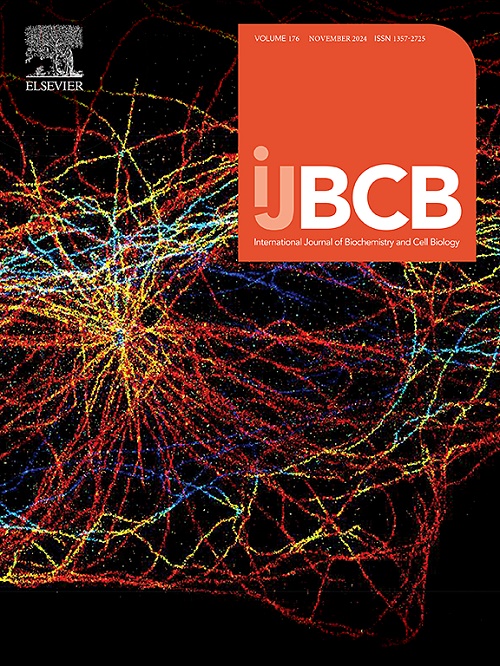集成体和单细胞RNA测序通过机器学习识别辐射诱导小鼠肺损伤的氧化应激特征。
IF 2.8
3区 生物学
Q2 BIOCHEMISTRY & MOLECULAR BIOLOGY
International Journal of Biochemistry & Cell Biology
Pub Date : 2025-09-16
DOI:10.1016/j.biocel.2025.106863
引用次数: 0
摘要
背景:放射性肺损伤(RILI)是胸部放疗患者的常见并发症。目前还没有有效的早期诊断生物标志物,临床治疗方法也非常有限,这给癌症患者的管理带来了巨大的挑战。氧化应激已被认为是衰老和疾病的关键中介。因此,本研究结合小鼠多组学数据和先进的生物信息学和机器学习方法,系统分析与氧化应激相关的分子特征,筛选RILI临床相关的生物标志物和分子机制。本研究旨在为RILI的早期诊断和针对性干预提供及时、实用的理论依据。方法:利用先进的生物信息学方法,我们实施了一种综合的方法,整合了大量RNA和单细胞RNA测序分析。这些技术包括消除批处理效应以促进平稳的数据集成、执行差异表达分析和应用加权基因共表达网络分析(WGCNA)。此外,我们利用随机森林和支持向量机(SVM)算法开发了RILI诊断模型。我们还进行了基因本体(GO)、京都基因与基因组百科全书(KEGG)和基因集富集分析(GSEA)。为了评估免疫细胞浸润,我们采用了单样本基因集富集分析(ssGSEA)和CIBERSORT算法。然后,我们利用单细胞RNA测序数据研究了模块基因在不同细胞群体中的表达和相互作用。最后,通过逆转录聚合酶链反应(RT-PCR)和免疫组织化学(IHC)验证辐照肺组织中模块基因的表达。结果:共鉴定出286个差异表达基因(DEGs)。其中,我们确认了61个与氧化应激(OSRDEGs)相关的基因。我们构建了9个共表达模块,其中4个显示出与RILI显著相关,包含来自这些模块的53个基因。构建了AUC大于0.9的诊断模型,并进一步完善了包括5个关键基因:Stk4、Aaas、Ets1、Sesn2和Kit,通过LASSO回归验证了其准确性。模型基因被发现在关键通路中富集,特别是MAPK信号通路。通过GeneMANIA鉴定的20个功能相似的蛋白中,发现了Ets1和Kit之间的直接关系。此外,我们注意到13种免疫细胞类型的浸润模式发生了显著变化,包括活化B细胞和活化CD4 T细胞。在粒细胞和内皮细胞中分别发现了高表达的Sens2和Kit。在小鼠RILI模型中,Sesn2和Aaas显著上调,而Stk4、Ets1和Kit下调。结论:我们深入的生物信息学分析揭示了RILI的重要分子事件,确定了5个关键基因及其相关信号通路。这些见解加深了我们对RILI发展和进展机制的理解,并为治疗和早期诊断提供了实用有效的方法。本文章由计算机程序翻译,如有差异,请以英文原文为准。
Integrated bulk and single-cell RNA sequencing identifies oxidative stress signatures of radiation-induced lung injury in mice through machine learning
Background
Radiation induced lung injury (RILI) is a common complication in patients undergoing thoracic radiotherapy. At present, there are no effective early diagnostic biomarkers, and clinical treatment methods are very limited, which poses a huge challenge to the management of cancer patients. Oxidative stress has been recognized as a key mediator of aging and disease. Therefore, this study integrated multiple omics data in mice and advanced bioinformatics and machine learning methods to systematically analyze the molecular features associated with oxidative stress, and screened for clinically relevant biomarkers and molecular mechanisms of RILI. This study aims to provide a timely and practical theoretical basis for the early diagnosis and targeted intervention of RILI.
Method
We implemented a comprehensive approach that integrated both bulk RNA and single-cell RNA sequencing analyses, utilizing advanced bioinformatics methodologies. These encompassed techniques aimed at eliminating batch effects to facilitate smooth data integration, executing differential expression analyses, and applying weighted gene co-expression network analysis (WGCNA). Furthermore, we developed a diagnostic model for RILI utilizing random forest and support vector machine (SVM) algorithms. We also conducted Gene Ontology (GO), Kyoto Encyclopedia of Genes and Genomes (KEGG), and Gene Set Enrichment Analysis (GSEA). To evaluate immune cell infiltration, we employed Single-Sample Gene-Set Enrichment Analysis (ssGSEA) alongside the CIBERSORT algorithm. We then investigated the expression and interactions of module genes across various cell populations utilizing data derived from single-cell RNA sequencing. Ultimately, the expression of module genes in irradiated lung tissues were validate by reverse transcription–polymerase chain reaction (RT-PCR) and immunohistochemistry (IHC).
Results
Our study identified a total of 286 differentially expressed genes (DEGs). Among these, we confirmed 61 genes related to oxidative stress (OSRDEGs). We constructed nine co-expression modules, four of which showed a significant association with RILI, encompassing 53 genes from these modules. A diagnostic model with AUC over 0.9 was constructed and further refined to include five key genes: Stk4, Aaas, Ets1, Sesn2, and Kit, which were validated for accuracy through LASSO regression. The model genes were found to be enriched in crucial pathways, particularly the MAPK signaling pathway. A direct relationship between Ets1 and Kit was found, which extended to 20 functionally similar proteins identified through GeneMANIA. Additionally, we noted significant changes in the infiltration patterns of 13 immune cell types, including Activated B cells and Activated CD4 T cells. Sens2 and Kit were found highly expressed in granulocytes and endothelial cells, respectively. In mouse models of RILI, Sesn2 and Aaas were significantly upregulated, whereas Stk4, Ets1, and Kit were downregulated.
Conclusion
Our thorough bioinformatics analysis reveals significant molecular events in RILI, identifying 5 key genes and their related signaling pathways. These insights deepen our understanding of the mechanisms underlying the development and progression of RILI and suggest a practical and effective approach for treatment and early diagnosis.
求助全文
通过发布文献求助,成功后即可免费获取论文全文。
去求助
来源期刊
CiteScore
8.10
自引率
0.00%
发文量
124
审稿时长
19 days
期刊介绍:
IJBCB publishes original research articles, invited reviews and in-focus articles in all areas of cell and molecular biology and biomedical research.
Topics of interest include, but are not limited to:
-Mechanistic studies of cells, cell organelles, sub-cellular molecular pathways and metabolism
-Novel insights into disease pathogenesis
-Nanotechnology with implication to biological and medical processes
-Genomics and bioinformatics

 求助内容:
求助内容: 应助结果提醒方式:
应助结果提醒方式:


